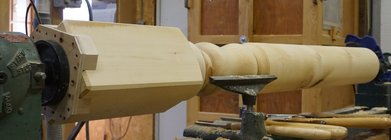I have a General 2060 lathe with a mechanical variable speed drive (to which I have added a vfd). It's a bit noisy but otherwise has worked well until recently when it froze up due to insufficient lubrication. I was able to get it back in order, but for anyone out there with the same model or similar grease-able variable pulley drive, don't forget to pull out the grease gun periodically. It has probably been a year since I last did it, and the fact that the mechanism slings a bit of grease around the inside the motor pedestal is a disincentive that I should have overcome.
I didn't take any pictures, but I will describe the gear for anyone needing to service it. The heart of the drive is a double sheave in between the motor and the headstock spindle. It spins on bronze bushings around a shaft attached to the speed control dial. When the dial is rotated the double sheave pivots up or down and the central disc of the sheave shifts sideways between the fixed outer flanges, forcing one v-belt outward and the other inward to change the headstock rpm's. The central sheave and the motor platform are secured with Allen keys on a stout vertical post depending from the headstock casting.
To get at the double sheave I first removed the motor platform. Loosening the keys on the double sheave allowed pivoting it away from the quadrant gear of the speed control and disengaging the drive belts, at which point the sheave and its wrist mount could come off the vertical shaft. The sheave was removed from its inner spindle by removing a spring clip.
Once the grub screws were removed from the outer sheave flanges the sleeve on which they are mounted was forced out with an arbor press. A very slight amount of corrosion was found and removed from the central disc and sleeve and the sheave reassembled on the sleeve. The central disc slides freely, but the outer discs are a press fit.
I found that the original spacing of the discs was not ideal. When one belt is close to bottoming out at the sheave center, the other belt should be at the maximum sheave diameter, giving the maximum speed variation. I pressed one of the outer flanges in almost 3/16" farther than the factory setting, drilled new seats for the grub screws, and reassembled the works.
Much of this work was done lying on the floor in an awkward position, and could have been avoided with better maintenance. "Eppur si muove"
I didn't take any pictures, but I will describe the gear for anyone needing to service it. The heart of the drive is a double sheave in between the motor and the headstock spindle. It spins on bronze bushings around a shaft attached to the speed control dial. When the dial is rotated the double sheave pivots up or down and the central disc of the sheave shifts sideways between the fixed outer flanges, forcing one v-belt outward and the other inward to change the headstock rpm's. The central sheave and the motor platform are secured with Allen keys on a stout vertical post depending from the headstock casting.
To get at the double sheave I first removed the motor platform. Loosening the keys on the double sheave allowed pivoting it away from the quadrant gear of the speed control and disengaging the drive belts, at which point the sheave and its wrist mount could come off the vertical shaft. The sheave was removed from its inner spindle by removing a spring clip.
Once the grub screws were removed from the outer sheave flanges the sleeve on which they are mounted was forced out with an arbor press. A very slight amount of corrosion was found and removed from the central disc and sleeve and the sheave reassembled on the sleeve. The central disc slides freely, but the outer discs are a press fit.
I found that the original spacing of the discs was not ideal. When one belt is close to bottoming out at the sheave center, the other belt should be at the maximum sheave diameter, giving the maximum speed variation. I pressed one of the outer flanges in almost 3/16" farther than the factory setting, drilled new seats for the grub screws, and reassembled the works.
Much of this work was done lying on the floor in an awkward position, and could have been avoided with better maintenance. "Eppur si muove"

